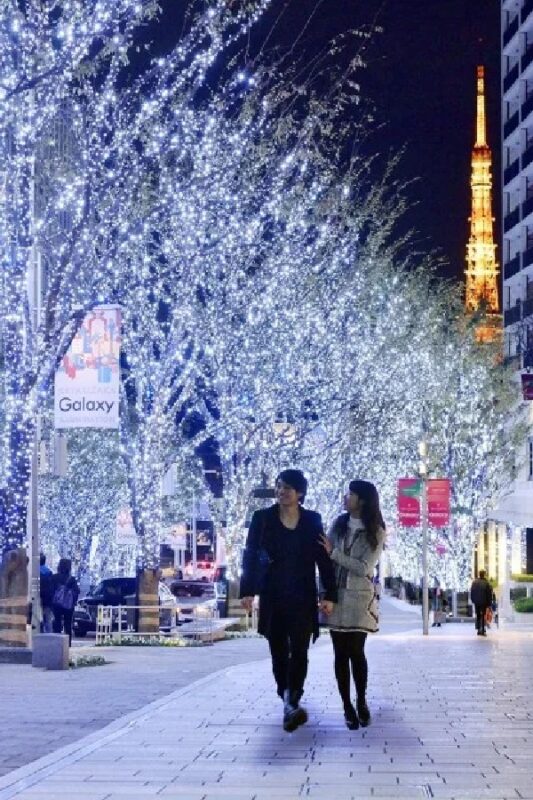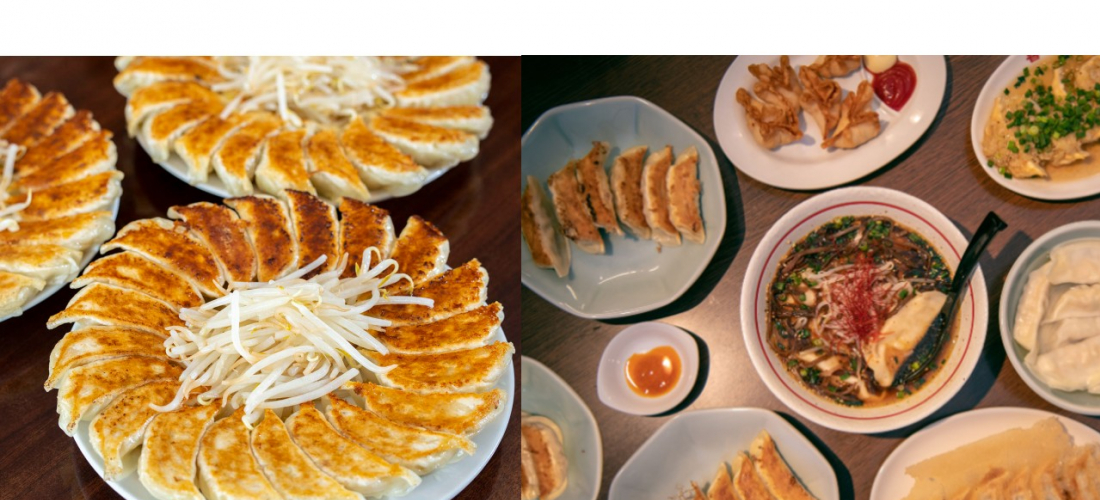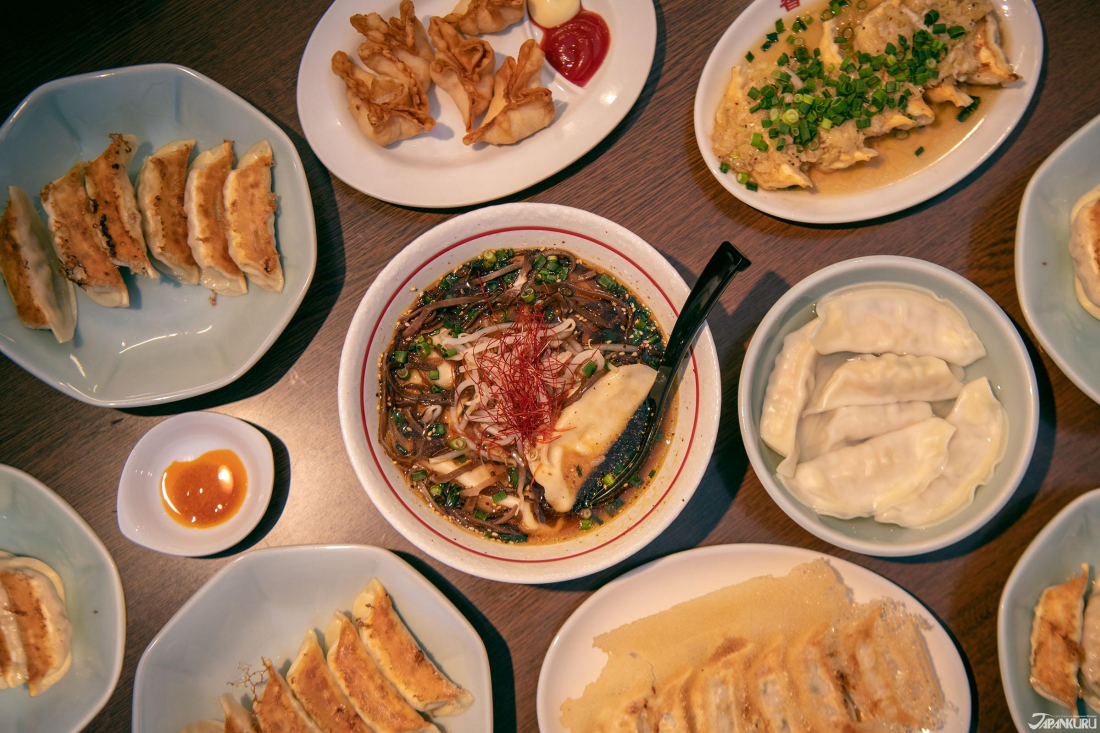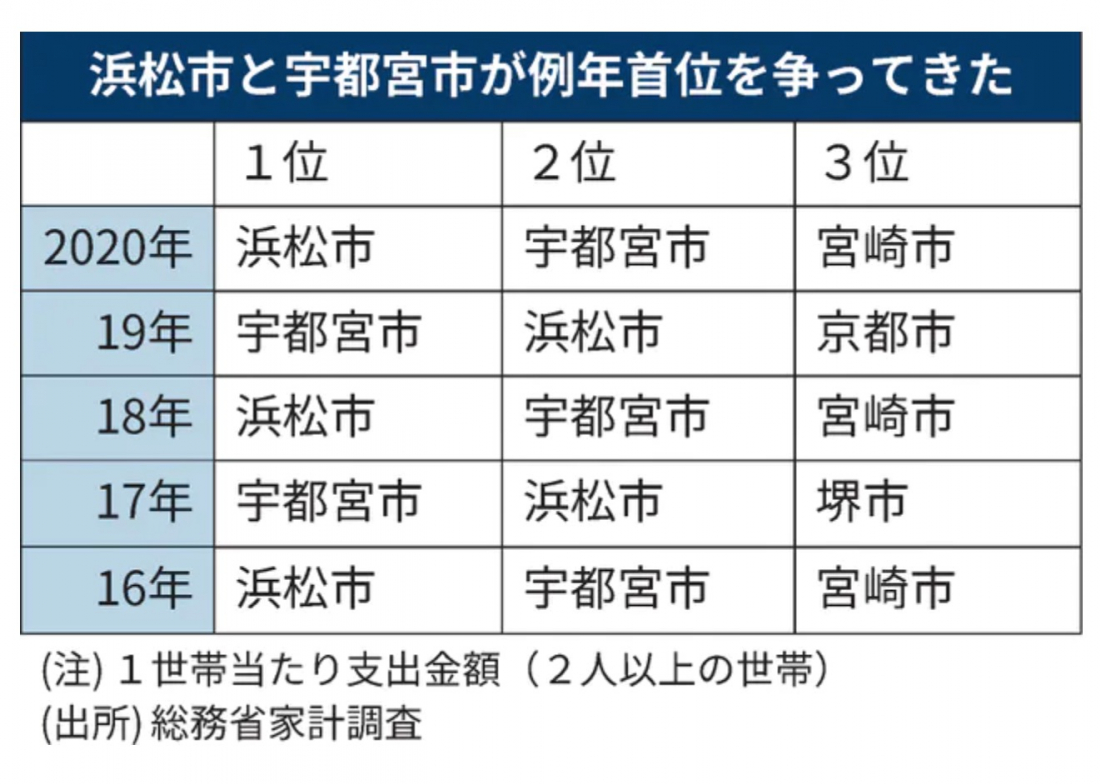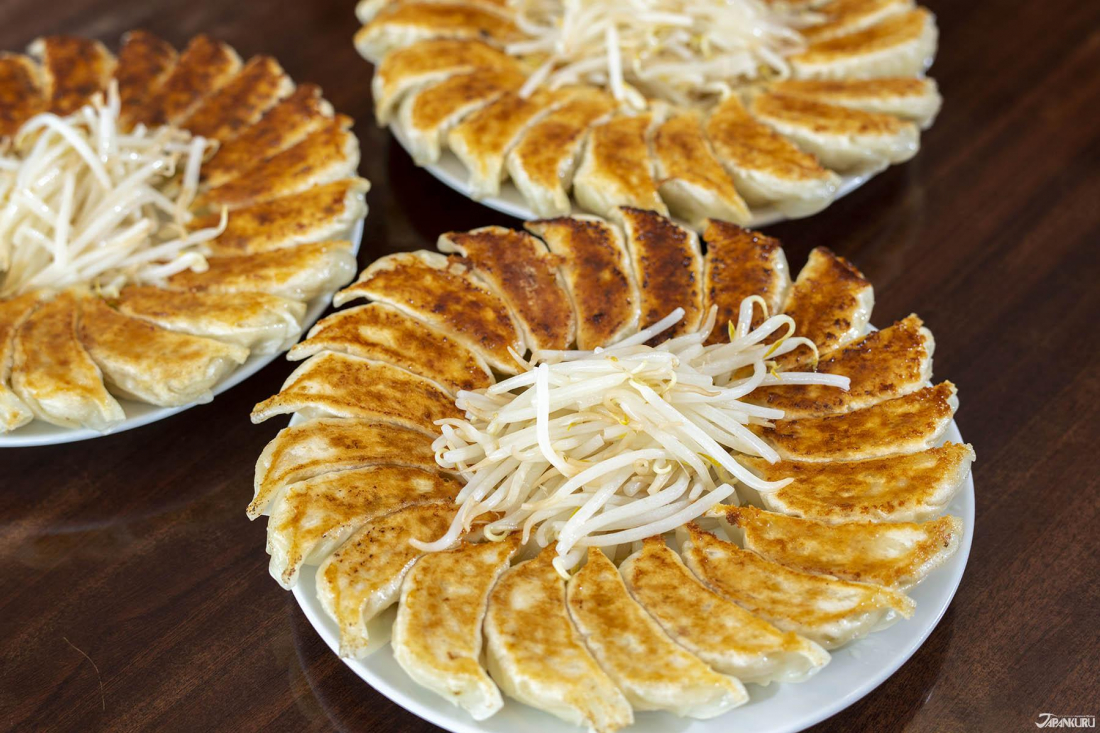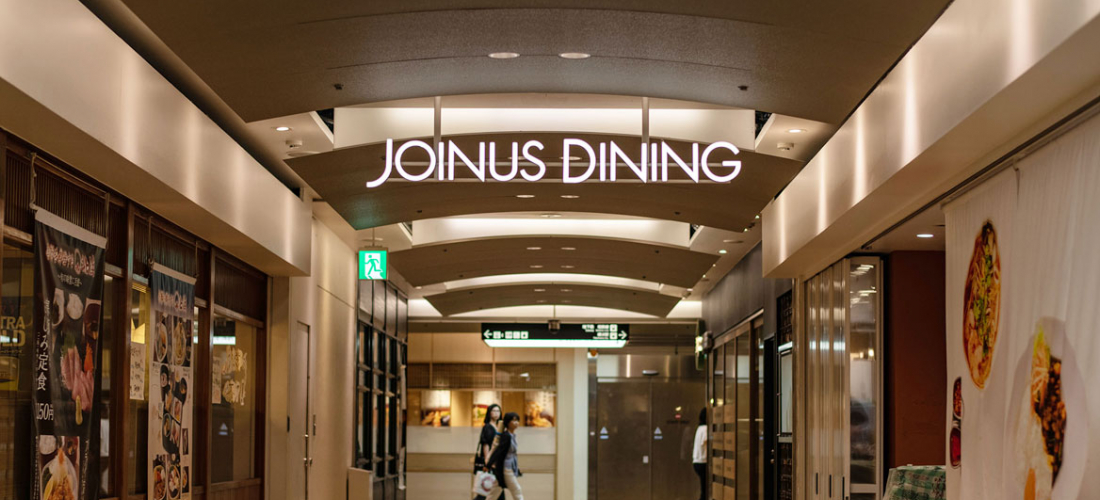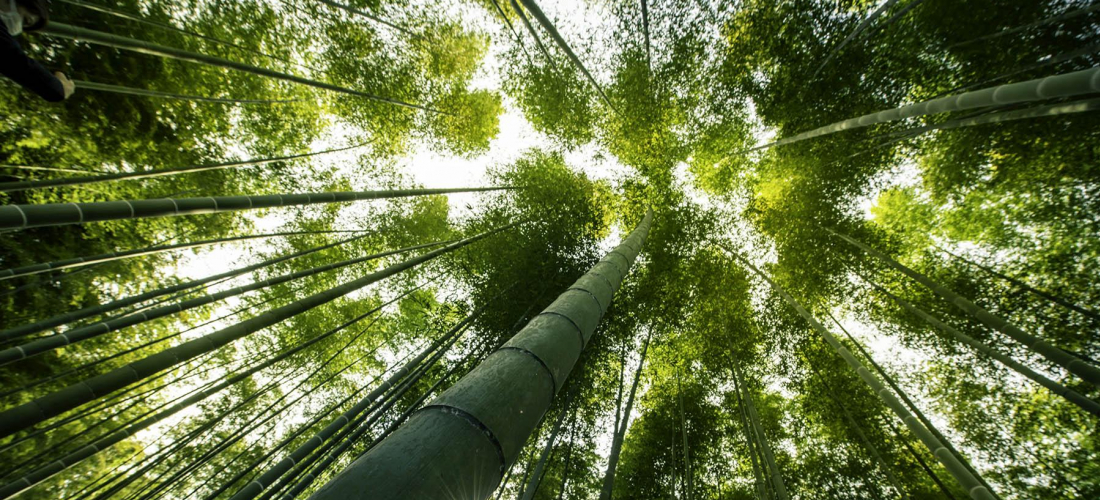CONTENTS
Gyoza are simple dumplings eaten as casual fare, but a fierce gyoza battle has long been brewing between the cities of Japan.
The Wonderful World of Japanese Gyoza
The little dumplings we call "gyoza" (餃子) actually originate from China, and are still (to some extent) considered Chinese food in Japan. But over the decades, these delectably savory dough-wrapped morsels have become a permanent fixture in Japan, as a standard size dish with ramen or a great match for a frosty mug of beer. These days, they're such common local fare that regions and restaurants all over Japan offer their own takes on the classic, and some regional gyoza variations have become so popular that they've made a name for themselves across the country.
To find the best gyoza in Japan, perhaps it's no surprise that dumpling experts like to rank the different varieties and establish which regions are hotspots for delicious gyoza, in the same way that Japan has almost-official rankings like the "Three Great Gardens," "Three Great Waterfalls," or the "Three Great Festivals of Edo." But when it comes to gyoza, the top-three approach has run into a bit of an obstacle over the past decade: two cities are so famous for their delicious gyoza, that they're fiercely battling for the #1 spot, and poor old #3 tends to get left behind. Our top competitors are the city of Utsunomiya, in Tochigi Prefecture, and the city of Hamamatsu, not far from Mt. Fuji in Shizuoka Prefecture.
What’s This Battle All About?
How exactly are Utsunomiya and Hamamatsu battling it out? Well, this competition isn't only about quality, but about quantity too. Each year, through a Home Statistics survey, Japan's Ministry of Internal Affairs and Communications asks households all over Japan about what and when they're eating, and it turns out how many gyoza each household consumes is an important national statistic. Thanks to that valuable information, we now know that since the year 2009―for over a decade―these two gyoza-obsessed cities have taken up the number 1 and 2 spots, consistently eating more gyoza per household than any other city in Japan. According to a Nikkei report, the two cities have even been switching off each year for the past five years, taking turns at number one. In the 2020 statistics, published recently, Hamamatsu has come out on top, replacing Utsunomiya.
Of course, for travelers just looking to grab a bite of the tastiest gyoza around, these statistics are less important than flavor. When it comes to the regional gyoza themselves, the origins of both Utsunomiya and Hamamatsu gyoza are similar. After World War II, troops that had been stationed in Manchuria (the north-eastern tip of China) returned to Japan with a taste for the local dumplings they had eaten while overseas, starting the gyoza trend all over the country. But what happened from there, in the kitchens of home cooks and local eateries, as chefs tailored the dumplings to local tastes―that's what has transformed the simple gyoza into a fantastic regional array!
Utsunomiya Gyoza: Fresh, Light, and Varied
Any non-vegetarian dumpling lover will know that for most gyoza, the filling for these savory little nuggets is mostly made up of meat, with a sprinkling of vegetables and other seasonings for flavor. In Utsunomiya, however, the ratio is flipped upside-down! A mix of vegetables makes up most of the body of the filling, with just a little ground meat added for flavor. Even when fried up hot and crispy, the result is a more refreshing dumpling with a relatively low price to boot, and that makes Utsunomiya gyoza popular among students and anyone looking for a lighter meal.
The dipping sauce for Utsunomiya gyoza has something of a lighter feel, too. In most gyoza spots around Japan, you'll see customers mixing up their own blend of soy sauce, vinegar, and perhaps a dash of chili oil. In Utsunomiya, this blend tends to be especially vinegar-heavy, cutting right through the rich greasiness of the fried dumplings for a clean bite.
One last feature of Utsunomiya gyoza is the variety, which is clear when visiting the city's many gyoza shops. The dumplings are pan-fried, boiled, and deep-fried, with simple fillings of cabbage, chives, and ground pork, or unique fillings including fun additions and toppings like mentaiko (明太子, spicy cod roe) or cheese. The "Utsunomiya gyoza" has a fairly loose definition, not very strictly maintained, but generally promoted by organizations like the Utsunomiya Gyoza Association. Travelers looking to see what Utsunomiya gyoza are all about can visit shops like Kirasse (Japankuru stopped by a few years back), a gyoza-only food court run by the Gyoza Association, with counters from some of the city's most popular gyoza shops, including the famous Minmin.
Unfortunately, not every popular gyoza shop in the city is part of the Utsunomiya Gyoza Association, which means it might be worth checking out some other shops to see what else the world of Utsunomiya gyoza has to offer. On a recent trip, a Tochigi-native tour guide told the Japankuru team that his personal favorite was a shop on somewhat rocky terms with the Gyoza Association, a place called Masashi. The gleaming recommendation made it clear that we had a new restaurant to try next time we were in Utsunomiya!
No matter where you try your Utsunomiya gyoza, one way to eat like a local is to order boiled gyoza, and then pour your "dipping sauce" right into the bowl instead of using a little dish!
Hamamatsu Gyoza: Simple and Savory
"Hamamatsu gyoza" refers generally to dumplings made in the city of Hamamatsu, but the title has slightly more specific requirements than the name "Utsunomiya gyoza" does. For one, gyoza shops in Hamamatsu need to be established and running for at least three years before they can adopt the official title of "Hamamatsu gyoza." On top of that, the image of the Hamamatsu gyoza tends to be a little more set in stone. These dumplings tend towards very simple fillings, made mostly of pork meat and some kind of onion or chive.
The real flare of Hamamatsu comes out when they're cooked. Google "Hamamatsu gyoza," and you'll find one picture after another featuring beautiful rings of perfectly pan-fried gyoza, served unbroken on a platter with a pile of bright white beansprouts at the center. This iconic serving style for Hamamatsu gyoza was developed by the early street vendors who made gyoza popular in the city. With just small round pans available to fry the gyoza in, these small-scale chefs would squeeze as many dumplings as they could manage onto the pans by lining them up around the edge. Of course, this left the street vendors with beautiful rings of golden-brown gyoza, and kind of a sad, empty circle at the center. Soon enough, sellers started filling up the hole with cheap beansprouts, and the fresh crunch of the veggies turned out to be the perfect thing to accompany the city's extra-savory extra-meaty dumplings.
For Hamamatsu gyoza, different shops tend to have their own special recipes, ranging in flavor from sweet to sour, and even some particularly spicy versions. Since Hamamatsu gyoza gain popularity through street vendors, and even more permanent restaurants tend to do a good takeout business, it's a long-lived tradition for shops to offer little containers of sauce for customers to take with them. At first, the sauce came in little aluminum bottles! Nowadays, they've mostly been replaced by plastic packets. Ishimatsu Gyoza, which the Japankuru team visited in early 2020, is not one of the city's more famous gyoza shops (they claim to be the very first gyoza stand established in Hamamatsu!), but they also pride themselves on their unique dipping sauce.
According to the Hamamatsu Gyoza Society, Hamamatsu gyoza aren't just a tasty snack in the city, but a true piece of local culture. Hamamatsu has always been a city of industry, and for many local factory workers, there's nothing better than coming home after a long day of work to see their family making gyoza together at home. Perhaps this heartwarming image is part of what makes the dumplings so delicious―it's almost certainly why the people of Hamamatsu ate more gyoza per household than any other city, last year.
Immersing Yourself in the Fun of Japanese Gyoza Culture
Are you starting to crave gyoza yet? Utsunomiya and Hamamatsu are particularly famous for gyoza in terms of both quality and quantity, and both cities make especially popular varieties of the dumplings (before consuming huge numbers of them), but gyoza are popular all around Japan! In terms of sheer numbers, cities like Miyazaki and Kyoto often make it onto the per household ranking at the #3 spot! And the "Three Great Gyozas" or "Three Gyoza Capitals" of Japan tend to include Hamamatsu and Utsunomiya as two of the three, but cities like Yahata in Fukuoka, or sometimes Yokohama (famous for its Chinatown) are often named as the third city, thanks to their own uniquely delicious gyoza recipes. While exploring Japan, part of the fun is to find unique local specialties wherever you end up, and we'd definitely recommend checking out some of Japan's most famous regional gyoza during your travels. The true gyoza capital of Japan is for you to decide!
For more info and updates from Japan, check Japankuru for new articles, and don't forget to follow us on Twitter, Instagram, and Facebook!
Details
NAME:Japanese Gyoza
Japankuru's head Chinese editor: mid-30s, likes to write, draw, and take photos. Aiming to become an old aunty with a girlish look. Articles written in Chinese by Lucy Wu, and translated by Sophia Appelbaum.
COMMENT
FEATURED MEDIA
VIEW MORE 
A New Tokyo Animal Destination: Relax & Learn About the World’s Animals in Japan
#pr #japankuru #anitouch #anitouchtokyodome #capybara #capybaracafe #animalcafe #tokyotrip #japantrip #카피바라 #애니터치 #아이와가볼만한곳 #도쿄여행 #가족여행 #東京旅遊 #東京親子景點 #日本動物互動體驗 #水豚泡澡 #東京巨蛋城 #เที่ยวญี่ปุ่น2025 #ที่เที่ยวครอบครัว #สวนสัตว์ในร่ม #TokyoDomeCity #anitouchtokyodome

Shohei Ohtani Collab Developed Products & Other Japanese Drugstore Recommendations From Kowa
#pr #japankuru
#kowa #syncronkowa #japanshopping #preworkout #postworkout #tokyoshopping #japantrip #일본쇼핑 #일본이온음료 #오타니 #오타니쇼헤이 #코와 #興和 #日本必買 #日本旅遊 #運動補充能量 #運動飲品 #ช้อปปิ้งญี่ปุ่น #เครื่องดื่มออกกำลังกาย #นักกีฬา #ผลิตภัณฑ์ญี่ปุ่น #อาหารเสริมญี่ปุ่น

도쿄 근교 당일치기 여행 추천! 작은 에도라 불리는 ‘가와고에’
세이부 ‘가와고에 패스(디지털)’ 하나면 편리하게 이동 + 가성비까지 완벽하게! 필름카메라 감성 가득한 레트로 거리 길거리 먹방부터 귀여움 끝판왕 핫플&포토 스폿까지 총집합!
Looking for day trips from Tokyo? Try Kawagoe, AKA Little Edo!
Use the SEIBU KAWAGOE PASS (Digital) for easy, affordable transportation!
Check out the historic streets of Kawagoe for some great street food and plenty of picturesque retro photo ops.
#pr #japankuru #도쿄근교여행 #가와고에 #가와고에패스 #세이부패스 #기모노체험 #가와고에여행 #도쿄여행코스 #도쿄근교당일치기 #세이부가와고에패스
#tokyotrip #kawagoe #tokyodaytrip #seibukawagoepass #kimono #japantrip

Hirakata Park, Osaka: Enjoy the Classic Japanese Theme Park Experience!
#pr #japankuru #hirakatapark #amusementpark #japantrip #osakatrip #familytrip #rollercoaster #retrôvibes #枚方公園 #大阪旅遊 #關西私房景點 #日本親子旅行 #日本遊樂園 #木造雲霄飛車 #히라카타파크 #สวนสนุกฮิราคาตะพาร์ค

🍵Love Matcha? Upgrade Your Matcha Experience With Tsujiri!
・160년 전통 일본 말차 브랜드 츠지리에서 말차 덕후들이 픽한 인기템만 골라봤어요
・抹茶控的天堂!甜點、餅乾、飲品一次滿足,連伴手禮都幫你列好清單了
・ส่องมัทฉะสุดฮิต พร้อมพาเที่ยวร้านดังในอุจิ เกียวโต
#pr #japankuru #matcha #matchalover #uji #kyoto #japantrip #ujimatcha #matchalatte #matchasweets #tsujiri #말차 #말차덕후 #츠지리 #교토여행 #말차라떼 #辻利抹茶 #抹茶控 #日本抹茶 #宇治 #宇治抹茶 #日本伴手禮 #抹茶拿鐵 #抹茶甜點 #มัทฉะ #ของฝากญี่ปุ่น #ชาเขียวญี่ปุ่น #ซึจิริ #เกียวโต

・What Is Nenaito? And How Does This Sleep Care Supplement Work?
・你的睡眠保健品——認識「睡眠茶氨酸錠」
・수면 케어 서플리먼트 ‘네나이토’란?
・ผลิตภัณฑ์เสริมอาหารดูแลการนอน “Nenaito(ネナイト)” คืออะไร?
#pr #japankuru #sleepcare #japanshopping #nenaito #sleepsupplement #asahi #睡眠茶氨酸錠 #睡眠保健 #朝日 #l茶胺酸 #日本藥妝 #日本必買 #일본쇼핑 #수면 #건강하자 #네나이토 #일본영양제 #อาหารเสริมญี่ปุ่น #ช้อปปิ้งญี่ปุ่น #ร้านขายยาญี่ปุ่น #ดูแลตัวเองก่อนนอน #อาซาฮิ

Japanese Drugstore Must-Buys! Essential Items from Hisamitsu® Pharmaceutical
#PR #japankuru #hisamitsu #salonpas #feitas #hisamitsupharmaceutical #japanshopping #tokyoshopping #traveltips #japanhaul #japantrip #japantravel

Whether you grew up with Dragon Ball or you just fell in love with Dragon Ball DAIMA, you'll like the newest JINS collab. Shop this limited-edition Dragon Ball accessory collection to find some of the best Dragon Ball merchandise in Japan!
>> Find out more at Japankuru.com! (link in bio)
#japankuru #dragonball #dragonballdaima #animecollab #japanshopping #jins #japaneseglasses #japantravel #animemerch #pr

This month, Japankuru teamed up with @official_korekoko to invite three influencers (originally from Thailand, China, and Taiwan) on a trip to Yokohama. Check out the article (in Chinese) on Japankuru.com for all of their travel tips and photography hints - and look forward to more cool collaborations coming soon!
【橫濱夜散策 x 教你怎麼拍出網美照 📸✨】
每次來日本玩,是不是都會先找旅日網紅的推薦清單?
這次,我們邀請擁有日本豐富旅遊經驗的🇹🇭泰國、🇨🇳中國、🇹🇼台灣網紅,帶你走進夜晚的橫濱!從玩樂路線到拍照技巧,教你怎麼拍出最美的夜景照。那些熟悉的景點,換個視角說不定會有新發現~快跟他們一起出發吧!
#japankuru #橫濱紅磚倉庫 #汽車道 #中華街 #yokohama #japankuru #橫濱紅磚倉庫 #汽車道 #中華街 #yokohama #yokohamaredbrickwarehouse #yokohamachinatown

If you’re a fan of Vivienne Westwood's Japanese designs, and you’re looking forward to shopping in Harajuku this summer, we’ve got important news for you. Vivienne Westwood RED LABEL Laforet Harajuku is now closed for renovations - but the grand reopening is scheduled for July!
>> Find out more at Japankuru.com! (link in bio)
#japankuru #viviennewestwood #harajuku #omotesando #viviennewestwoodredlabel #viviennewestwoodjapan #비비안웨스트우드 #오모테산도 #하라주쿠 #日本購物 #薇薇安魏斯伍德 #日本時尚 #原宿 #表參道 #japantrip #japanshopping #pr

Ready to see TeamLab in Kyoto!? At TeamLab Biovortex Kyoto, the collective is taking their acclaimed immersive art and bringing it to Japan's ancient capital. We can't wait to see it for ourselves this autumn!
>> Find out more at Japankuru.com! (link in bio)
#japankuru #teamlab #teamlabbiovortex #kyoto #kyototrip #japantravel #artnews
Photos courtesy of teamLab, Exhibition view of teamLab Biovortex Kyoto, 2025, Kyoto ® teamLab, courtesy Pace Gallery

Japanese Makeup Shopping • A Trip to Kamakura & Enoshima With Canmake’s Cool-Toned Summer Makeup
#pr #canmake #enoshima #enoden #에노시마 #캔메이크 #japanesemakeup #japanesecosmetics

⚔️The Robot Restaurant is gone, but the Samurai Restaurant is here to take its place. Check it out, and don't forget your coupon!
🍣신주쿠의 명소 로봇 레스토랑이 사무라이 레스토랑으로 부활! 절찬 쿠폰 발급중
💃18歲以上才能入場的歌舞秀,和你想的不一樣!拿好優惠券去看看~
#tokyo #shinjuku #samurairestaurant #robotrestaurant #tokyotrip #도쿄여행 #신주쿠 #사무라이레스토랑 #이색체험 #할인이벤트 #歌舞伎町 #東京景點 #武士餐廳 #日本表演 #日本文化體驗 #japankuru #japantrip #japantravel #japanlovers #japan_of_insta

Japanese appliance & electronics shopping with our KOJIMA x BicCamera coupon!
用JAPANKURU的KOJIMA x BicCamera優惠券買這些正好❤️
코지마 x 빅 카메라 쿠폰으로 일본 가전 제품 쇼핑하기
#pr #japankuru #japanshopping #kojima #biccamera #japaneseskincare #yaman #dji #osmopocket3 #skincaredevice #日本購物 #美容儀 #相機 #雅萌 #日本家電 #일본여행 #면세 #여행꿀팁 #일본쇼핑리스트 #쿠폰 #일본쇼핑 #일본브랜드 #할인 #코지마 #빅카메라 #japankurucoupon
MAP OF JAPAN
SEARCH BY REGION

LATEST
VIEW MOREEVENT CALENDAR
VIEW MORE